Theatre Review
Rocklin Community Theatre
West Side Story - July 12-28, 2019
Over the past 7 years, I have seen many excellent shows put on by Rocklin Community Theatre, but the production of West Side Story that I saw on this Friday night was a breakthrough ― a breathtaking breakthrough. It was RCT’s first show to be produced “in the round.” Considering all the shows of theirs that I’ve seen in Rocklin’s Finnish Temperance Hall, I would have thought it impossible: the theatre is so small. But they built 4 rows of (comfortable) raked seating on either side of the room. And with 30 more seats on the usual “stage,” they were able to accommodate an audience of 158.
The idea was brilliant. The performance space at the center of the audience seating was surprisingly large, and it opened the way for the show’s truly remarkable dance numbers. There was, of course, the sense of intimacy in the close contact with the players. And the set-up managed to avoid my quibble with Sacramento’s Wells Fargo Pavilion. In the shows I’ve seen there, I’ve been too conscious of the audience members on the other side of the circular stage. In this RCT production, with the focused lighting on the performance space and the intense activity taking place there, I was hardly ever aware of the audience members seated across from me.
When I first entered the theatre, I worked my way through the
sell-out crowd, found my seat, and then my attention was immediately
drawn to two monitors on the wall above the entrance to the room. On the
left was the face of Music Director, Peter Kagstrom. On the right was a
panorama of the orchestra, ready to play in their location elsewhere in
the building. When have you
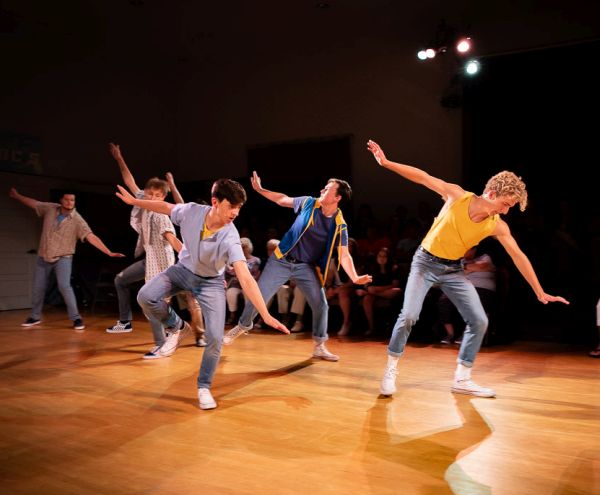 ever
heard of a community theatre production accompanied by a 27-piece
orchestra? I’ll answer that for you… never! The rich orchestration of
their performance enhanced every aspect of the show that was to come.
ever
heard of a community theatre production accompanied by a 27-piece
orchestra? I’ll answer that for you… never! The rich orchestration of
their performance enhanced every aspect of the show that was to come.
(Click here to open the playbill in a new window.)
This show had many excellences: the music, the singing, the acting.
But what I’ll remember the longest is the stunning quality of the
dancing. It hit me right away in the “Prologue.” It was a lengthy,
intricate, high-energy choreography that encapsulated the show to come.
It was the Sharks vs. the Jets, in an extraordinary combination of
grace, athleticism… and intimidation. One thought that ran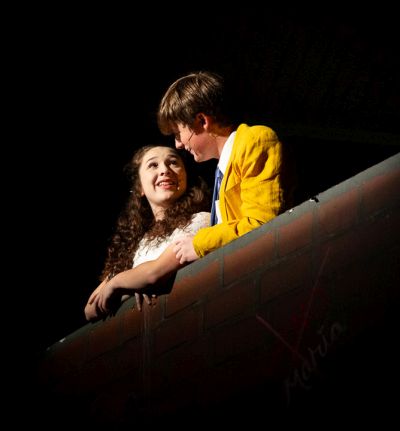 through my head was “How did they find so many young men who are such
good dancers?” Joined by the young women in the cast, they took
advantage of every inch of space in this innovative stage. Their dancing
was mesmerizing, and it was only the “prologue”! I don’t believe I’ve
seen the choreography of Brittany Cody Bays before, but I will be on the
lookout for her work in the future. It was fundamental to the dazzling
success of this show.
through my head was “How did they find so many young men who are such
good dancers?” Joined by the young women in the cast, they took
advantage of every inch of space in this innovative stage. Their dancing
was mesmerizing, and it was only the “prologue”! I don’t believe I’ve
seen the choreography of Brittany Cody Bays before, but I will be on the
lookout for her work in the future. It was fundamental to the dazzling
success of this show.
To me, this felt almost like a “dance show” because the choreography was such an integral part of almost every scene. But the acting was also top-notch. In the first scene “When You’re a Jet,” I saw compelling acting and perfect timing in rapid-fire-delivered lines that told me that each actor was living his part. That occurred to me first in Carson Sloan’s portrayal of the volatile Riff, but I saw it in just about every other person on stage.
There was hardly anything in this show that could be called a set. A
table and 4 chairs came and went in several scenes. Maria sang from a
balcony at a corner of the room, and Tony and Maria shared a bed below
the balcony ― but that was about it. So
how did this all work so well? The essence of the show is conflict
― conflict between the rival gangs,
conflict between the gangs and the adults, and conflict between many
sets of individuals. If there weren’t so much conflict, the improbable
love story wouldn’t stand out the way it does. And one doesn’t need much
of a set or props to dramatize the conflict ―
or the love. It is in the faces and gestures of the actors.
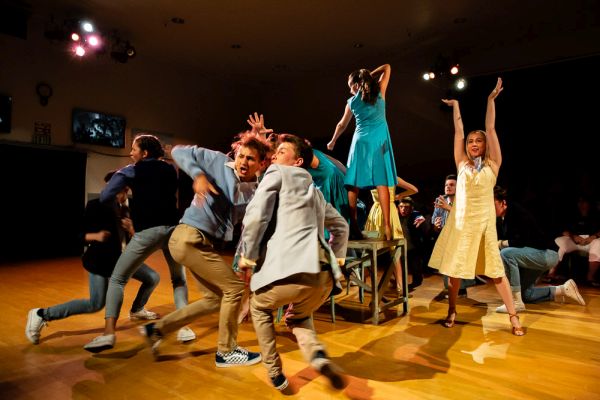 And
for that, I credit, not just the native talent of these young people,
but the inspiration and insights of Director Amanda Duisenberg. I know
she has drawn from her extensive stage experience because I’ve been
charmed by her singing and acting since I first saw her work in 2014.
And
for that, I credit, not just the native talent of these young people,
but the inspiration and insights of Director Amanda Duisenberg. I know
she has drawn from her extensive stage experience because I’ve been
charmed by her singing and acting since I first saw her work in 2014.
I have to believe that every person in that audience was as absorbed
in this show as I was. What made it so captivating? I have to say it was
the energy and the tension (essentially suppressed energy) that
permeated almost every scene. Every person on that stage gave their all
to channeling that energy, and for me it was especially memorable in the
“Dance at the Gym.” The very entry of the dancers at the beginning of
this scene was exciting, but the building tension between Puerto Ricans
and “Americans” was fascinating, especially when it played out in the
dance competition. And later, especially during the rumble, I thought
the fight choreography was excellent. It was so real, I wonder how many
times people might have gotten hurt during rehearsal.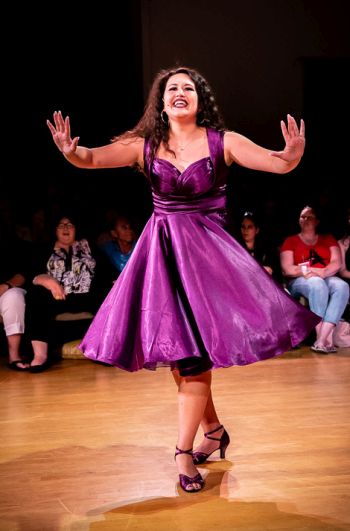
There was good ensemble singing, and I had to marvel at it because the large orchestra that was accompanying this singing was in another part of the building. But it was the singing of the individual performers that made this an authentic presentation of music that is so well-known and so much-loved. Maria (Isabella Vega) had a lovely soprano voice with a solid high register, and a natural accent and manner that captured the ethnicity of the part. From the first note he sang, I could see why Jaden Santini got the role of Tony, and his solid duets with Maria demonstrated the believable chemistry between them. Of course, there were other excellent voices: Jake Romero (Bernardo) and Abigail Dixon (Anita) were standouts, but honestly, I was never conscious of a weak voice.
Brilliant as these high-school and college-age performers were, let’s not overlook the “non-dancers.” I’ve seen Mike Mechanick in many roles over many years, and he always brings his best ― this time as the domineering Lt. Schrank. Angie Dixon was a great foil to the ethnic conflict at the dance as she tried to organize that activity. Mike Reinero as Officer Krupke was menacing and took a hard fall at one point, his sacrifice for art. And Ken Duisenberg, scion of the incredibly talented Duisenberg family took his daughter’s direction (or did he?) as Doc.
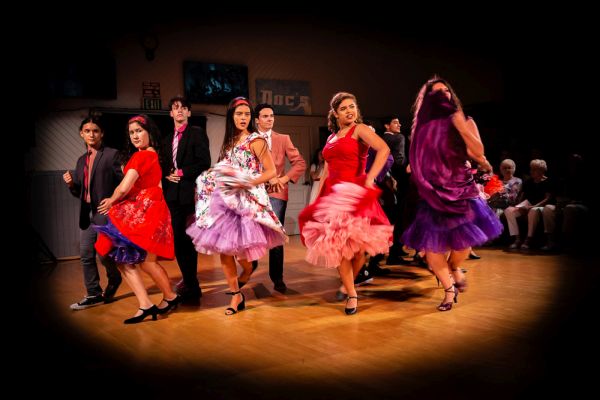 There’s
no question that West Side Story is a modern tragedy, but every
great tragedy has a bit of comedy for contrast. So this show was full of
clever humor, and this company played it up in the gentle sarcasm of
“America” and the heavy sarcasm of “Officer Krupke”
― and in the occasional clowning
around. I have to add that “Officer Krupke” was performed as a tap dance
number ― to the delight of the
audience, which erupted in applause as it concluded.
There’s
no question that West Side Story is a modern tragedy, but every
great tragedy has a bit of comedy for contrast. So this show was full of
clever humor, and this company played it up in the gentle sarcasm of
“America” and the heavy sarcasm of “Officer Krupke”
― and in the occasional clowning
around. I have to add that “Officer Krupke” was performed as a tap dance
number ― to the delight of the
audience, which erupted in applause as it concluded.
Of the many highpoints in this show, the dance that seemed to flow from the imagination of Tony and Maria was extraordinary. They had resolved to find “a place for us” despite Tony’s having killed Bernardo. This led to a graceful, happy extended dance scene in which all the Sharks and Jets appeared dressed all in white, interacting harmoniously with each other ― until this surreal scene morphed into hostility and a pantomime repeat of the rumble that ended in two deaths. I don’t remember having witnessed this scene before in West Side Story. Was it an innovation from this production’s creative team? If so, it was a brilliant concept. If not, it was still brilliantly executed.
I haven’t said enough about the acting. Everything I saw in these characters felt genuine to me, but Chino’s telling Maria of the death of her brother Bernardo was a highpoint. Chino (Mason Santa Catalina) set the scene perfectly, and Maria’s reaction was Broadway-worthy. It wasn’t just acting that I was witnessing ― these young people were giving us personality that enhanced everything they did. And the closing scene that ended with everyone gathered around Tony’s lifeless body was performed so well that we in the audience couldn’t fail but be moved.
This production of West Side Story is a tribute to the consistent commitment to innovation and quality of Rocklin Community Theatre. I have seen many of their shows since 2012 (fewer in recent years), and I’ve never failed to be impressed by the quality …of the acting and directing, …of the live music and …of the creativity in staging accomplished in a very small space. This show, however, seemed to raise RCT’s high standards to a new level, and good as this show is, I bet they regret that they scheduled only 9 sold-out performances.
(This show ran July 12-28, 2019. For more information about Rocklin Community Theatre, visit www.rocklintheatre.org.)
Photos courtesy of Amy Finch.
Dick Frantzreb is past editor of the Sacramento Choral Calendar and co-founder and past President of the Sacramento Valley Choral Coalition. He currently edits the Placer Performance Calendar and the new Capital Region Performance Gallery. He has been loving live performances in the greater Sacramento area and writing about them since 2012.